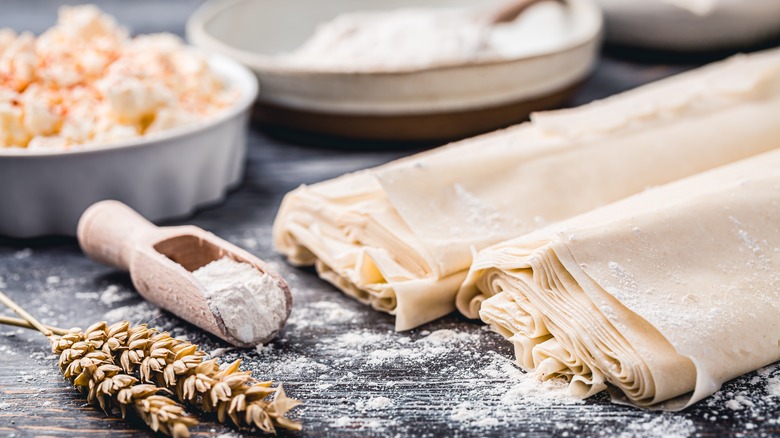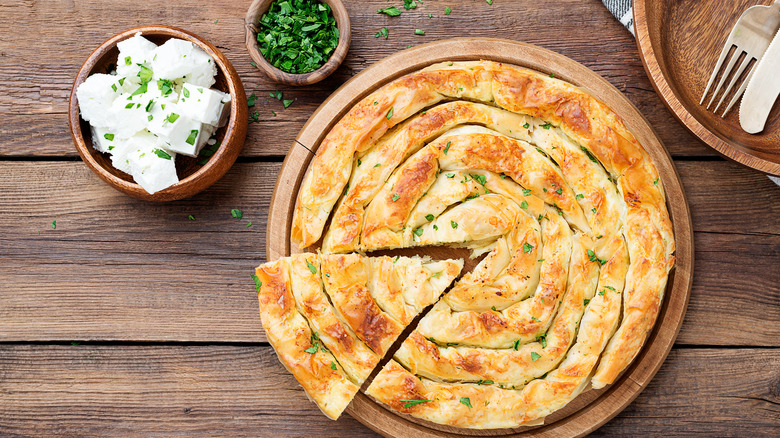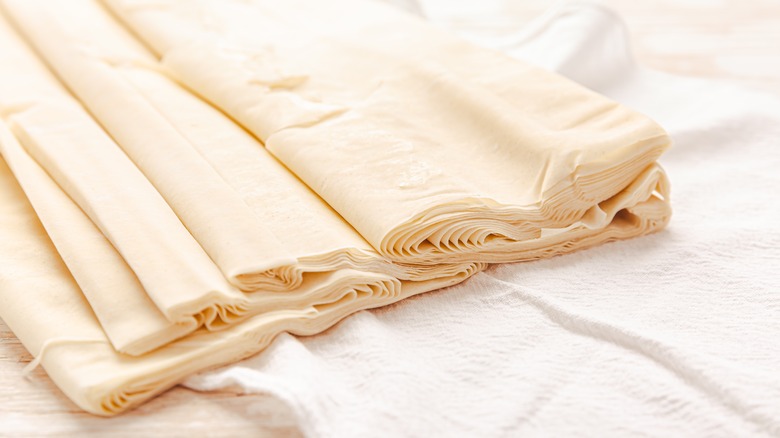Give Your Casserole An Extra Layer Of Crunch With Phyllo Dough
You might know phyllo dough as the star ingredient in popular Middle Eastern and Balkan dishes, from spanakopita and baklava to hearty burek. Beyond its classic applications, however, the unleavened dough is a clever ingredient to have on hand for non-traditional bakes. This is true of TikTok's viral crinkle cake, but in this case, we're talking about casseroles.
When draped and crimped over a casserole dish, phyllo lends an ASMR-worthy layer of crunch and makes for a lovely presentation. Thanks to its delicate texture and mild, buttery taste, the paper-thin pastry dough makes a particularly good match for the heavy or otherwise bold-flavored ingredients that casseroles often contain.
While bread puddings and other carb-heavy versions might not need it, phyllo is a must-try for meat- and vegetable-based bakes. Here are some ideas to get you started on your phyllo casserole journey, plus some tips to keep in mind when working with the fragile stuff.
Spin tradition
When you start experimenting with phyllo dough as a casserole-topper, you might find it helpful to reach for ingredients inspired by traditional dishes. For something closely akin to spanakopita, Greece's answer to spinach pie, build a casserole from spinach, feta, garlic, onion, and fresh herbs, laying a few sheets of phyllo over the top before baking. By skipping the process of including phyllo on both the top and bottom of the casserole dish, this version is slightly less involved than the original.
Feeding a crowd of meat eaters? For proof that ground beef or pork pairs wonderfully with phyllo dough, look no further than burek. Though variations abound, we're thinking specifically of Serbian burek, which often includes a filling of ground meat, eggs, chopped onion, and fresh herbs baked into a round phyllo disc that's sliced like a pizza and served with tangy yogurt. A casserole spin-off version might simply involve spreading the meaty mixture into a dish and topping it with the flaky dough.
When it comes time to bake, phyllo recipes usually favor ovens in the 325 to 350 degree Fahrenheit range, from anywhere between 20 minutes to an hour. To be on the safe side, check your casserole often to make sure the phyllo isn't burning. Ideally, it should come out of the oven looking golden brown.
Managing your dough
When it comes to phyllo dough, store-bought is the way to go. Most grocery stores carry it in the baking section of the freezer aisle in long rectangular packages. You might also find frozen puff pastry in this section, but keep in mind that they're not the same thing. The former is relatively low in fat, while the latter contains large amounts of butter that make it significantly puffy as it bakes.
Keeping phyllo in the freezer means it lasts a long time, but it also means you need to thaw it before use. To do so, transfer it to the fridge at least eight hours before you plan to unroll it and start on your casserole.
When that time comes, manage the thin dough quickly but carefully by working with a couple of sheets at a time with wet fingers, keeping the remaining sheets between two damp kitchen towels to prevent them from drying out. Last but not least, don't forget to brush your layers of phyllo with oil or melted butter before baking. Not only does that extra fat help the dough take on a golden hue, but it also stops it from burning.


